|
Give Bees a Chance
Honeybees have problems, but native bees can take up the slack. Danielle Venton checks out the buzz on the farm. Illustrated by Chelsea Crist and Julie Naylor.

Illustration: Chelsea Crist
Not long ago, Chris Schlies's almond orchard was covered by oak trees, grasses, and wildflowers. Native bees of every size and color buzzed among the wild roses and California poppies. Now, nut trees in neat columns stretch in all directions—except in one patch. In his newest planting, he has put native flowers, grasses, and shrubs back on his land. Schlies has a new bee garden.
Farmers, like Schlies, could not manage without bees. Each year, after his trees swell with buds and erupt into bloom, he needs bees to visit every tree in his orchard. Each nut is the result of a bee's visit. He hopes his sparse patch of young native plants will take root, flourish and welcome back some of the native bees that once flew here.
Before the age of large-scale agriculture, farmers didn't need domesticated honeybees. Native bees pollinated crops grown in small fields as they made their rounds among native plants. As crops bloomed throughout the year, those resident bees visited many times. Now, agriculture consortiums grow food in huge plots of a single crop. For bees, this is the equivalent of a restaurant opening one week of the year to serve all-you-can-eat spaghetti. Native bees can't handle the feast followed by famine, so when crops are in bloom, farmers hire domesticated bees by the truckload.
 Bee-pollinated crops, such as apples, cherries, and cauliflower, make up one-third of our diet and provide half of our Vitamin C. But in recent years, honeybees have suffered from “colony collapse disorder”—a strange affliction blamed on disease, stress, and poor nutrition. Beekeepers nationally reported losing 30 to 90 percent of their hives in a single season, sometimes overnight. These dramatic drops have only accelerated a trend: honeybees have declined since the 1950s, according to the U.S. Department of Agriculture (USDA). Bee-pollinated crops, such as apples, cherries, and cauliflower, make up one-third of our diet and provide half of our Vitamin C. But in recent years, honeybees have suffered from “colony collapse disorder”—a strange affliction blamed on disease, stress, and poor nutrition. Beekeepers nationally reported losing 30 to 90 percent of their hives in a single season, sometimes overnight. These dramatic drops have only accelerated a trend: honeybees have declined since the 1950s, according to the U.S. Department of Agriculture (USDA).
The honeybee (Apis mellifera), a European import, isn't alone in its troubles. Entomologists are seeing native bees disappear, too. A study released in early 2011 recorded the range and abundance of eight native bumblebee species; four showed severe declines. The authors also heard many anecdotal reports from researchers who had studied a particular bee for decades and were seeing it vanish.
With his new garden, Schlies is part of a small movement to welcome native bees back to the farm. They'll enjoy their garden year-round—and during a few critical weeks each spring, Schlies hopes, the bees will fly into his trees. California's agricultural future just may depend on it.
Bloom break
The almond bloom, called the "bloom break," is the pollination event of the year. California produces 1.5 billion pounds of almonds annually—80 percent of the world's crop. From late February to early March, farmers amass an army of pollinators: half of the nation's commercial honeybee hives, from as far away as Florida, according to the California State Beekeepers Association.
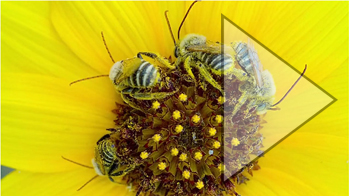 |
| Video: Danielle Venton visits California's Central Valley during the almond "bloom break" and talks with Chris Schlies about his bee garden. (Click on image to see video.) |
|
Schlies hires these domesticated honeybees, and his pollination costs have risen dramatically. “It cost $32 to rent a hive in the mid-90s,” says Schlies, who rents about two-and-a-half hives per acre for his family's 85 acres of almond trees in the San Joaquin Valley. Now, he says, “it's leaped up to $150 a hive”—an annual difference of $25,000.
It will take a few years to see whether his 7,000-square-foot experiment will pay off. Schlies planted the garden with help from Jessa Guisse, a pollination expert from the Xerces Society, a conservation organization. They do not know which bees will come, but Guisse expects to see bumblebees of all stripes. Bumblebee queens are some of the earliest to emerge in spring, and they'll forage on the almond flowers, Guisse thinks.
Schlies feels optimistic that the native bee garden will let him rent fewer hives. Almond growers in the Capay Valley, west of Sacramento, don't rent honeybees because they live near enough undisturbed hills, forests, and wild fields where native bees thrive. If Schlies can reduce rentals by three-quarters of a hive per acre, he could save $10,000 or more annually. Then, he'd put bee gardens in his other orchards, too.
The professor and the bee
The seeds of his bee garden began to germinate when Schlies read about pollination research in farming publications. His attention was piqued by a 2006 study coauthored by Claire Kremen, a conservation biologist at UC Berkeley.
Kremen had found that in a hybrid crop system like sunflowers, where rows alternate between male and female flowers, native bees working alongside honeybees can make overall pollination five times more efficient. If left alone, honeybees methodically travel along a row; individuals often specialize in collecting pollen or nectar. Native bees, on the other hand, have erratic flight paths, switching between this row and that. Many natives are also solitary bees—and the males need to find their own mates. They will investigate everything that flies. If a male native bee approaches a honeybee, the honeybee will flit to a different flower or row.
Kremen, winner of a 2007 MacArthur 'genius' grant, started studying native bees in the late 1990s. After returning to the U.S. from Madagascar, where she led the design of Masoala National Park, she decided she wanted to study native pollinators. She suspected that farm plots near countryside habitats benefited from the services of wild bees, far more than farms surrounded by other farms. In 2002, she showed that on farms close to such habitat—such as some organic watermelon farms in Yolo County, west of Sacramento—native bees provided complete pollination.
But native bees don't require pristine conserved land to thrive, Kremen showed; they do just fine on human-designed habitat as well.
 In 2007, she was part of a team to document that wild bees provide sufficient crop pollination in a human-dominated landscape. In the study's region, New Jersey and Pennsylvania, farmers rarely hire honeybees. Although humans use the land heavily, it's a bee haven with small crop sizes, diverse crops, and suburban gardens abounding in nesting sites and flowers. In 2007, she was part of a team to document that wild bees provide sufficient crop pollination in a human-dominated landscape. In the study's region, New Jersey and Pennsylvania, farmers rarely hire honeybees. Although humans use the land heavily, it's a bee haven with small crop sizes, diverse crops, and suburban gardens abounding in nesting sites and flowers.
Maintaining the vitality of native bees is crucial, says Kremen. Depending on the area, bees pollinate 60 to 90 percent of the plants. Nearly 40 percent of the planet's land is tied to agriculture, according to the World Bank. “Globally, if we want to have wildlife diversity, we must have diversity on farmland,” she says.
Kremen has shifted her focus from conserving pristine land to re-wilding the farm. It too can support wild things, she says. She calls this “conservation in the matrix”—a web of living, active land, more like a city block crowded with small cafes.
Kremen believes that modern agriculture, unchecked, will collapse under its own weight. It takes too much from the earth—relying on pesticides, fertilizers, imported pollinators—and gives too little back. Based on her findings, Kremen and her collaborators believe that boosting native pollinators on farms will both help the environment and save money for farmers. Her lab is now working to build an economic model to calculate the costs and benefits of creating new habitat by planting bee gardens and hedgerows.
No one has done this for native bees on farmland before. Considering the variables, it's difficult. So Kremen's research team is both patient and inventive.
On wild bee safari
At farms in Yolo County, the team tracks the bees that use hedgerows—lanes of plants that edge fields, stretching for thousands of feet. It's a traditional British practice. Landowners planted hedges at pasture or property lines as fences and windbreaks, not for pollinator habitat.
Most of these hedgerows, roughly 15 years old now, were planted for aesthetics, for game animals such as quail, or to filter water runoff, Kremen says. She thinks it will be a revelation when her team can give the farmers data describing the rows' benefits, such as more thorough pollination, better crop yields, improved control of pests and erosion, and water  management. management.
The hedgerows contain California lilac, coyote brush, and other native shrubs and grasses in pollen and nectar-rich tangles. By comparing the number and variety of bees found in these areas to those on farms without hedgerows, researchers can compare how successful the plants are at helping the natives.
On netting days, the team slowly walks through the fields with a stopwatch. For exactly an hour, they watch for insects, pausing the timer as they untangle the bug from the net and pop it into a jar. They also collect with “pan traps”—bowls filled with soapy water on which bees land, sink, and drown.
More pollinators might be in an area thanks to new habitat, but farmers also want to know how deeply they fly into the field. A concern is that hedgerows will attract desired insects and keep them there, like a resort they never want to leave.
A graduate student who recently joined Kremen's lab, Hillary Sardinas, is addressing this question by creating checkpoints. In a field she sets sticky cards, adhesive placards about the size of a DVD case, on stakes at regular distances from a hedgerow. A couple hours later she collects the cards and the insects that have smashed into them, revealing which insects venture forth and how far they're willing to fly.
Farmers also need to know whether native pollinators are visiting the crop plants. Biologists can’t keep an eye on every flower, so they ask the bees.
“You've heard the phrase the bees knees? Well, some bees store pollen in 'pollen baskets' on their knees,” explains Sardinas. “It refers to the most concentrated source of sweetness. So you can just net a bee, scoop off the pollen from one leg, and then see what flowers they've been visiting by looking at what kind of pollen it is under a high-powered microscope. It's always easy to tell which bees you've sampled—they look a little lopsided,” she adds.
In their job of collecting pollen and nectar, bees can only fly so far. Lengthy foraging trips can exhaust bees. Shalene Jha, a former postdoctoral scholar in the lab, wants to know who is related to whom in the field, and how far they must fly. Bumblebee genetics are her specialty.
Just like honeybees, bumblebees are social insects. With a little bee catching and a little DNA sampling, it's easy to figure out how many native colonies dot a landscape. Jha can tell which bees are sisters and which bees are from different hives. Genetic diversity should help the bees cope as they face climate change and pests. So far, she's finding multiple colonies in both natural and agricultural landscapes, but the natural areas have more diverse bumblebee populations.
Jha used to collect her samples by netting insects, killing them, and taking them back to the lab. All she needs for her test, though, is a tiny sample, just two millimeters off the bee's foot. She uses a contraption they call the “bee squeezer.” After netting a bumblebee, she quickly plops it into a tube that looks like a narrow toilet paper roll. She pushes in a padded plunger to gently squeeze it against netting at the end of the tube. With a pair of scissors she snips a little section of leg, then lets the bee go.
“This way we can get a DNA sample without killing them, which we'd rather not do,” says Jha. “Bumblebees are really fun to work with because they are so gentle. It's very easy to bring students out. Within five minutes, they are expert bee catchers.”
Bewildering varieties
 By summer's end, the lab has collected thousands of insects and hundreds of types. The world contains 20,000 kinds of bees, 1,600 of which are California natives. By summer's end, the lab has collected thousands of insects and hundreds of types. The world contains 20,000 kinds of bees, 1,600 of which are California natives.
Sardinas pulls a large open box from a drawer at UC Berkeley to show the Kremen lab's reference collection. It's an insect graveyard, containing hundreds of bees pinned in neat rows. Many of these would never pass for bees in a lineup. Some are so small they look like gnats, some are elongated and gangly, and others are enormous and fuzzy.
 Lab members can't identify all the bees. There are too many kinds, and the differences between some species are too subtle. They send their tricky bees to Robbin Thorp, an entomologist at UC Davis—the only man in the region up to the task, Sardinas says. Lab members can't identify all the bees. There are too many kinds, and the differences between some species are too subtle. They send their tricky bees to Robbin Thorp, an entomologist at UC Davis—the only man in the region up to the task, Sardinas says.
She picks up a metallic, forest green “hairy-belly bee.” “Osmia ribifloris, this is possibly my favorite," Sardinas says. "They look like a jewel when you see them in the field.” [See sidebar, "Backyard Buzz," on how to attract bees to your garden.]
Proving valuable
The ongoing work by Kremen and her team will bolster their economic model. But her earlier results already have had an impact. The USDA's Natural Resource Conservation Service (NRCS) incorporated Kremen's research into programs to encourage wild habitats. Under the state's 2008 Farm Bill, growers who manage part of their lands for native bees are reimbursed for 50 to 90 percent of their costs—including such efforts as the bee garden in Chris Schlies's orchard.
Kremen's work is important for its novelty and vision, says entomologist Sydney Cameron, who studies insect behavior at the University of Illinois. “It's probably the first [such] research that got attention from agricultural and conservation societies,” Cameron says. The findings helped Cameron secure USDA funding to survey the health of U.S. bumblebee populations, she believes.
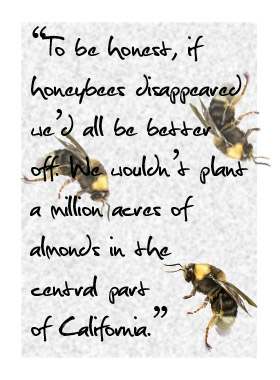 “The bottom line is the dollar; it drives everything,” Cameron says. “If you’re not aware that wild bees help in crop pollination, farmers will keep doing the same thing—spraying and bringing in honeybees. But to be honest, if honeybees disappeared I think we’d all be better off. We wouldn’t plan a million acres of almonds in the central part of California, and we'd have much more diversity. We might actually learn how to commercially raise other solitary bees that are wonderful pollinators.” “The bottom line is the dollar; it drives everything,” Cameron says. “If you’re not aware that wild bees help in crop pollination, farmers will keep doing the same thing—spraying and bringing in honeybees. But to be honest, if honeybees disappeared I think we’d all be better off. We wouldn’t plan a million acres of almonds in the central part of California, and we'd have much more diversity. We might actually learn how to commercially raise other solitary bees that are wonderful pollinators.”
Even with attention from the USDA, research funding for native bees is meager compared to that for honeybees, Cameron notes.
Kremen also is eager to see farmers reduce their reliance on honeybees. "I'm not trying to be alarmist, but my work does sound a cautionary note," she says. "We have a honeybee that has many problems, yet we rely on it for so much of our agriculture."
Our food-growing habits cannot last, says Kremen, who now sees the world through a “bee's-eye” perspective. She feels it isn't enough merely to promote native bees; she wants to change farming as a whole. Diversified farming—more hedgerows, smaller plots, multiple crops, fewer chemicals—are her priorities. They're also practical, she maintains. Kremen is starting a new center at UC Berkeley to study how to implement diversified farming and to reach out to farmers, the public, and policymakers.
The busiest bees?
Meanwhile, Schlies will watch how his bee garden grows. “These natives used to be everywhere, and now they've dwindled so," he says. "If you can give someone economic motivation to restore habitat and make it a trend, maybe that's a way to reverse some of what commercial agriculture has done over the years.”
He knows growers in the area will pay attention to his project. His farm manager, also an orchard owner, says that if the bee garden is successful, he'll plant one on his own land too.
“The economic justification is just one of several of my motivations,” Schlies says. “I don't think I'll know for a couple of years. It's not that much land I'm setting aside, maybe a couple hundred dollars of profit a year.” But he's confident that once enough native bees have made a home there, he'll put in a smaller order to the beekeepers.
Do his bees work as hard as he does? “No,” Schlies says with a laugh. “When it's cold they stay in their hives. I'm stuck working no matter what.”
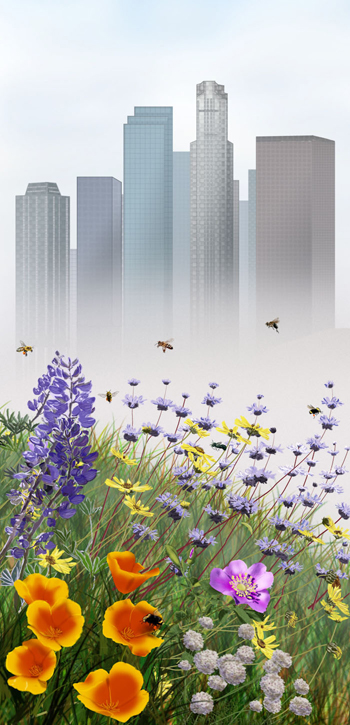 |
| Illustration: Julie Naylor |
|
Sidebar: Backyard Buzz
Enlightened farmers can help native bees thrive, but your own personal green patch can be a haven for bees, too. That's the central message of the Urban Bee Garden project in Berkeley, California, where gardeners and biologists have worked for two decades to attract bees to neighborhoods and keep them fed all year long.
Planting the right kinds of flowers—and a lot of them—is the first step toward seeing bees in your garden, says project director Gordon Frankie. He recommends planting at least 10 species of bee-attracting plants in untamed, wild masses. This usually gives bees the selection and abundance they need.
Choose flowers that you like, Frankie advises, and that grow in your area. Select plants that are right for your garden’s soil and sun exposure. Plant flowers that bloom in succession, to make sure bees have pollen and nectar in the lean fall and winter seasons. Encourage continuous blooming by “deadheading”—removing withered flowers.
Most bees, 80 percent, make their nests in the ground. To help them find a home, follow the lines of English gardens and let flowers grow free, avoiding the highly manicured French style. Heavy mulch makes it impossible for bees to emerge from their nests in the ground, so spread it thinly or not at all. And if possible, don't use pesticides.
Some people are afraid to attract bees to their garden, Frankie says, but bees are quite gentle and shy. In decades of work no one on his research team has been stung on the job.
Gardeners can choose from many native and exotic plants on the garden's website. Among the popular flowers that bees love are:
Borage (Borago officinalis)
California Buckwheat (Eriogonum fasciculatum)
California Poppy (Eschscholzia californica)
Catmint (Nepeta (cataria))
Cosmos (Cosmos bipinnatus)
Horehound (Marrubium vulgare)
Lamb's Ear (Stachys Byzantia)
Lavendar (Lavandula)
Midnight Penstemon (Penstemon x glaxinioides)
Phacelia Grandiflora (Phacelia grandiflora)
Pincushion Flower (Scabiosa columaria)
Rosemary (Rosmarinus officinalis)
Sunflower (Helianthus gracilientus and Helianthus annuus)
Tansy Phacelia (Phacelia tanacetifolia)
Story © 2011 by Danielle Venton. For reproduction requests, contact the Science Communication Program.
Top
Biographies
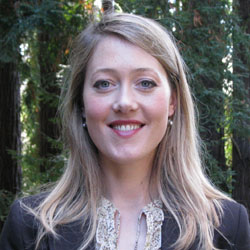 Danielle Venton Danielle Venton
B.S. (biology) Humboldt State University
Internship: Wired.com (San Francisco)
Aside from being useless behind a microscope, I’m in science writing for the variety. Like many a writer before me, I love language, learning, and talking about science. I love new experiences that deepen my understanding of the world and its people. Science writing gives both author and reader access to every field touched upon by research—which is to say, every field there is.
I’ve worked in science communication from many places: the redwoods of Northern California, the ponds of Cape Cod's National Seashore, and the caverns of the Large Hadron Collider, the largest particle accelerator, at CERN in Geneva. Every new place, every new project, teaches me something and broadens my perspective. The world will always have something new to teach us, and science writing allows me to remain its student.
. . . . . . . . . . . . . . . . . . . . . . . . . . . . . . . . . . . . . . . . . . . . . . . . . . .
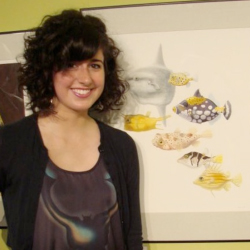 Chelsea Crist Chelsea Crist
B.F.A. (communication design) Kutztown University
Internship: Carnegie Museum of Natural History (Pittsburgh)
Armed with the valuable skills I’ve learned from CSU Monterey Bay and my undergraduate degree, I hope to do beautiful work for the Carnegie Museum of Natural History and go on to illustrate for science magazines and field guides.
. . . . . . . . . . . . . . . . . . . . . . . . . . . . . . . . . . . . . . . . . . . . . . . . . . .
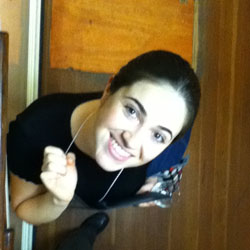 Julie Naylor Julie Naylor
A.S. (general science) Santa Monica College
B.S. (accounting) Loyola Marymount University
Internships: Natural History Museum of Los Angeles County (Vertebrate Paleontology Department) and New Zealand Marine Studies Centre
Julie is from Santa Monica, California. She has had a lifelong love for art and nature, and has found the Science Illustration program to be a wonderful, enriching experience. She especially enjoys illustrating extinct species.
Top |

